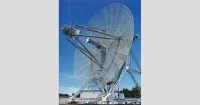Iron Dome is a mobile, all-weather air defense system developed in Israel to intercept and destroy short-range rockets and artillery shells. It targets projectiles aimed at populated areas within a range of 4 to 70 kilometers. Developed by Rafael Advanced Defense Systems and Israel Aerospace Industries, Iron Dome has received significant financial support from the United States, totaling $1.6 billion between 2011 and 2021, with an additional $1 billion approved in 2022.
1995: Joint Development of Nautilus Laser Defense System
From 1995 to 2005, the United States and Israel jointly developed the Nautilus laser defense system, but scrapped the system after concluding it was not feasible, having spent $600 million.
1996: Development and Deployment of Nautilus Prototype
In 1996, the Israelis developed the Nautilus prototype and later deployed it in Kiryat Shmona, Israel's northernmost city along the Lebanese border. The Nautilus used components from other systems and successfully kept a beam on the same point for two continuous seconds using an early prototype of the Green Pine radar. Although Nautilus proved the concept was feasible, it was not deployed operationally, as the government favored ground troops to stop rocket fire at the source.
2005: Nautilus Laser Defense System Scrapped
From 1995 to 2005, the United States and Israel jointly developed the Nautilus laser defense system, but scrapped the system after concluding it was not feasible, having spent $600 million.
2005: Program Start for Research and Demonstration
In 2005, Brig. Gen. Danny Gold, then head of Maf'at, decided to start the program to research and demonstrate the intercepting system.
2006: War with Hezbollah
In the 2006 war with Hezbollah, prior to Iron Dome's development, 4,000 rockets landed during 34 days of fighting, resulting in 53 Israeli deaths. About 30,000 insurance claims for rocket-related damage were filed.
February 2007: Iron Dome Selected for Defense
In February 2007, Defense Minister Amir Peretz selected Iron Dome as Israel's defense against short-range rocket threats.
2007: Israel Commissions Development of Iron Dome
In 2007, Israel commissioned the development of Iron Dome, selecting Israeli contractor Rafael over Lockheed Martin. mPrest Systems was tasked with programming the core of Iron Dome's battle management system. The system went from the drawing board to combat readiness in under four years.
2008: Criticism of Iron Dome's Effectiveness Against Qassam Rockets
In 2008, prior to its deployment, the Iron Dome was criticized as ineffective in countering the Qassam threat for the southern city of Sderot, given the short distance and flight time between Sderot and rocket launching pads in Gaza. Israeli defense officials insisted that with recent improvements, Iron Dome was fully able to intercept Qassams.
2008: Operation Cast Lead
Research published in 2018 analyzed Operation Cast Lead, which took place in 2008-2009.
2009: Operation Cast Lead
Research published in 2018 analyzed Operation Cast Lead, which took place in 2008-2009.
May 2010: Obama Requests Funding for Iron Dome
In May 2010, President Barack Obama requested $205 million from Congress in his 2011 budget to support the production and deployment of additional Iron Dome batteries. A few days later, the U.S. House of Representatives approved the funding in a 410–4 vote.
2010: Criticism of Iron Dome's Cost
In 2010, before Iron Dome was declared operational, military analyst Reuven Pedatzur criticized its cost compared to Qassam rockets, suggesting that large numbers of Qassams could attack Israel's financial means. Rafael responded that the cost issue was exaggerated, as Iron Dome intercepts only rockets determined to be a threat, and the lives saved and strategic impact justify the cost.
March 2011: Iron Dome Initially Deployed
In March 2011, Iron Dome was declared operational and initially deployed near Beersheba.
March 2011: Iron Dome Deployed for the First Time
On 27 March 2011, Al Jazeera English reported that the Iron Dome had been deployed for the first time near Beersheba. Brigadier-General Doron Gavish, commander of Israel's air defense corps, indicated that Iron Dome had passed a series of tests and reached its "evaluation phase" following two rocket attacks on the area that month.
April 2011: IDF to Finalize Long-Term Acquisition Program
According to Haaretz, in April 2011 the IDF was set to finalize its long-term Iron Dome acquisition program named "Halamish" within a few months. Israel Air Force officials estimated that thirteen Iron Dome systems were needed to cover threatened areas. A scholar at the Institute of National Security Studies in Tel Aviv, Meir Elran, suggested that Israel would need 20 batteries to adequately defend its borders with Gaza and Lebanon, requiring financial assistance from the United States.
April 2011: Iron Dome Successfully Intercepts Rockets
In April 2011, following the system's deployment, Iron Dome was used to successfully intercept Katyusha rockets fired by Palestinian militants. In August 2011, Iron Dome intercepted 20 missiles and rockets fired into Israel. However, the system destroyed four rockets fired at Beersheba but failed to stop a fifth, which killed one man and injured several others.
April 2011: First Successful Interception by Iron Dome
On 7 April 2011, after deployment as an "operational experiment" on 3 April, the Iron Dome system near Ashkelon successfully intercepted a Grad rocket fired at the city. This marked the first time a short-range rocket fired from Gaza had been intercepted. Subsequently, an IAF aircraft attacked the squad that had fired the rocket. The IDF clarified that the system was still under evaluation. On 8 April, the system successfully intercepted another four rockets.
April 2011: First Successful Interception
On April 7, 2011, the Iron Dome system successfully intercepted a rocket launched from Gaza for the first time.
May 2011: Israel to invest Nearly $1 Billion
On May 9, 2011, it was announced that Israel plans to invest nearly $1 billion in the coming years for the development and production of Iron Dome batteries.
August 2011: Palestinian militants change rocket-launching tactics
In August 2011, Israeli security sources reported that Palestinian militants altered their rocket-launching tactics to evade the Iron Dome systems deployed in southern Israel. These new tactics involved aiming at areas beyond the Iron Dome's protection range and launching volleys of rockets simultaneously.
August 2011: Rafael to invest in second Iron Dome production line
In August 2011, Rafael announced it would invest tens of millions of shekels to open a second production line for the Iron Dome's Tamir interceptor missiles. This expansion was driven by future operational needs and the plan to build two more Iron Dome batteries by the end of the year.
August 2011: Joint Venture Announcement for Iron Dome Variant
In August 2011, a joint venture called Area Protection Systems was announced to market a variant of the Iron Dome system. This development paralleled the co-production model of the Arrow 3 missile system between the US and Israel, indicating a growing trend of technological collaboration.
August 2011: Southern city mayors battle for Iron Dome deployment
In August 2011, the success of the Iron Dome system led to intense competition among southern city mayors to have it deployed in their areas. Despite the IDF's caution that it doesn't provide airtight protection, cities like Ashdod, Ofakim, Netivot, Beersheba, and Ashkelon were all vying for the system, while the IDF had only two available batteries.
August 2011: Iron Dome Intercepts Rockets Targeting Populated Areas
On 18 August 2011, four rockets were fired from Gaza at Ashkelon. The Iron Dome system determined that two of the rockets posed a threat and successfully intercepted them, while ignoring the other two because they were directed at non-populated areas. There were no reported injuries or damage. Defense officials also stated that the Iron Dome would be redeployed in Beersheba.
August 2011: Rocket Strikes Residential Area in Be'er Sheva
On 20 August 2011, while engaging a volley of seven rockets fired at Be'er Sheva from Gaza, one rocket was not intercepted by the Iron Dome system. It exploded in a residential area, killing one person. Brig. Gen. Doron Gavish stated that the system was not hermetic and was still in its first operational test. He also mentioned that the air defense units were learning and improving the performance of the Iron Dome system while operating it.
August 2011: Iron Dome System Redeployed near Ashkelon
On 5 August 2011, following days of heightened rocket fire from Gaza into Israel, the IDF redeployed the Iron Dome system near Ashkelon. This redeployment came a day after Ashkelon mayor Benny Vaknin requested it from Prime Minister Benjamin Netanyahu and Defense Minister Ehud Barak.
August 2011: IAF Deploys Third Iron Dome Battery
On August 31, 2011, the IAF deployed a third Iron Dome battery outside of Ashdod. Defense Minister Ehud Barak praised the IDF and the IAF Air Defense Division for deploying the battery ahead of schedule, before the opening of the school year.
August 2011: High Court rejects petition for Gaza border deployment
On August 8, 2011, the Israeli High Court of Justice rejected a petition to order the government to deploy the Iron Dome system in Gaza border communities. The court ruled that the government's decision not to deploy the system there was reasonable, considering budget constraints, security realities, and operational matters.
December 2011: Fourth Iron Dome Battery Deployment Announced
In December 2011, Brig. Gen. Gavish announced that a fourth Iron Dome battery would be deployed in the "coming months." Additionally, Capt. Roytal Ozen was appointed to command the battery's unit, becoming the first woman in charge of the system, highlighting the Air Defense Division's largest-ever draft of soldiers to meet increasing unit demands.
December 2011: Accident during Iron Dome maintenance drill
On December 26, 2011, an accident occurred during a maintenance drill where twenty Tamir interceptors fell from a height of four meters without detonating, rendering them unserviceable. An investigation was launched, and safety protocols were reviewed. The estimated damage was $1 million.
December 2011: Iron Dome Performance Analysis
On December 30, 2011, a Jerusalem Post report based on a performance analysis showed that Iron Dome successfully downed 75% of rockets from Gaza that it engaged. The analysis also revealed that a radar failure had previously caused some interceptors to miss their targets but had since been corrected.
December 2011: Potential Iron Dome deployment in Haifa Port considered
On December 6, 2011, Israeli Minister Matan Vilnai said the Defense Ministry was considering a permanent Iron Dome deployment in Haifa Port to protect oil refineries from Hezbollah rocket attacks due to the critical role of the refineries for the Israeli economy during wartime.
2011: US Funding Received
In 2011, the U.S. funding for Iron Dome was received. However, it took an additional 18 months before the additional batteries were delivered to the air force.
2011: US Contributions to Iron Dome
In 2011, the United States began contributing financially to the Iron Dome defense system, ultimately providing US$1.6 billion between 2011 and 2021.
2011: Iron Dome Begins Operating in Southern Israel
In early 2011, the Iron Dome system began operating, initially deployed at air force bases in southern Israel. Plans were made to set it up in other areas, such as Sderot, during significant escalations along the Gaza border.
2011: House Passes National Defense Authorization Act
On May 18, 2012, the House of Representatives passed the Fiscal Year 2013 National Defense Authorization Act, which included $680 million for Iron Dome in Section 227, also calling for technology sharing and co-production in the United States, in light of the nearly $900 million invested since 2011.
2011: U.S. investment in Iron Dome
Senate Report 113-211 from the U.S. Government Publishing Office, which accompanied text H.R. 4870, recommended an increase in funding for the program for FY2015. The report calculates "U.S. investment in Iron Dome production since fiscal year 2011" to be over $1 billion.
2011: Iron Dome Short-range Rocket Defense Program
The National Defense Authorization Act for Fiscal Year 2011 (Public Law 111-383) included $205.0 million for the Iron Dome short-range rocket defense system for the State of Israel. The committee also notes that if the full $680.0 million is used on the program, the total U.S. taxpayer investment in this system will amount to nearly $900.0 million since fiscal year 2011, yet the United States has no rights to the technology involved.
March 2012: System Shot Down 90% of Rockets
On March 10, 2012, it was reported that the Iron Dome system shot down 90% of rockets launched from Gaza that would have landed in populated areas.
April 2012: Increased Interception Range Predicted
On April 4, 2012, a senior Israeli official predicted an increased interception range of up to 250 kilometres for Iron Dome, as well as more flexible aiming of units.
May 2012: Pentagon Announces Support
On May 17, 2012, the Pentagon announced that the US President supports Israel's Iron Dome system and would provide $70 million in assistance for it.
May 2012: House Passes National Defense Authorization Act
On May 18, 2012, the House of Representatives passed the Fiscal Year 2013 National Defense Authorization Act, which included $680 million for Iron Dome in Section 227, also calling for technology sharing and co-production in the United States.
June 2012: Senate Committee Includes Funding
On June 4, 2012, the U.S. Senate Armed Services Committee included $210 million for Iron Dome in its version of the National Defense Authorization Act for 2013.
July 2012: Iron Dome Deployed in Eilat Area for Testing
On July 11, 2012, the Iron Dome system was deployed in the greater Eilat area as part of an IDF survey to test it in various areas across Israel. The IDF aimed to assess potential sites for permanently stationing additional batteries. This deployment followed earlier Katyusha rocket attacks from Sinai.
November 2012: Iron Dome Interceptions during Operation "Pillar of Defense"
During Operation "Pillar of Defense" (November 14–21, 2012), the Iron Dome system made 421 interceptions. On November 17, after two rockets targeted Tel Aviv, a battery was deployed in the area, intercepting a third rocket within hours. This marked the deployment of the fifth battery, ahead of its scheduled service in early 2013.
November 2012: Over 400 Rockets Intercepted
In November 2012, official statements indicated that the Iron Dome system had intercepted over 400 rockets.
2012: Israel Agreed to Early Cease-Fire Due to Ammunition Shortage
According to Ronen Bergman, in 2012, during Operation Pillar of Defense, Israel agreed to an early cease-fire because the Iron Dome anti-missile defense system had run out of ammunition. As a result, Israel tried to prepare larger stocks of interceptors for future rounds of fighting.
2012: Iron Dome Short-range Rocket Defense Program
In 2012, Section 227 of the National Defense Authorization Act authorized $680.0 million for the Iron Dome system in fiscal years 2012–15 for procurement, operations, and sustainment, while also requiring the establishment of a program office for cooperative missile defense efforts.
2012: Potential Increase in Demand for Additional Systems
In a 2012 op-ed in Haaretz, Jamie Levin suggested that the success of the Iron Dome system would likely increase demands to field additional systems across Israel. Budget shortfalls meant that Israel would be forced to weigh spending on missile defenses against other expenditures, potentially affecting social welfare programs.
2012: Operation Pillar of Defense
Research published in 2018 analyzed Operation Pillar of Defense which took place in 2012.
2013: Report Questions Iron Dome Effectiveness
In 2013, an unpublished report by Theodore Postol, Mordechai Shefer, and Richard Lloyd argued that the official effectiveness figures for Iron Dome during Operation Pillar of Defense were incorrect. Postol argued that Iron Dome's intercept rate was relatively low, possibly as low as 5%.
2013: Senate Committee Includes Funding
On June 4, 2012, the U.S. Senate Armed Services Committee included $210 million for Iron Dome in its version of the National Defense Authorization Act for 2013.
2013: House Passes National Defense Authorization Act
On May 18, 2012, the House of Representatives passed the Fiscal Year 2013 National Defense Authorization Act, which included $680 million for Iron Dome in Section 227, also calling for technology sharing and co-production in the United States.
2013: Availability of Funds for Iron Dome
Sec. 237 specified that, for fiscal year 2013, $210,000,000 may be provided to the Government of Israel for the Iron Dome short-range rocket defense program as specified in the funding table in section 4201.
January 2014: Obama Signs Appropriations Act
On January 17, 2014, President Obama signed the fiscal year 2014 Consolidated Appropriations Act, providing $235 million for Israel to procure the Iron Dome system.
July 2014: Raytheon to Partner in Co-Production of Tamir Missile Components
In July 2014, it was announced that Raytheon would be the major U.S. partner in co-production of major components for the Iron Dome's Tamir intercepting missile, with the U.S. firm to supply components through various subcontractors. Rafael and Raytheon had offered the Iron Dome launcher and Tamir interceptor, known as SkyHunter in the U.S., to the U.S. Army's Indirect Fires Protection Capability (IFPC) system, but Dynetics was chosen instead.
August 2014: Iron Dome performance during Operation Protective Edge
As of August 2014, during Operation "Protective Edge," ten Iron Dome batteries were deployed throughout Israel. Over the 50-day conflict, 4,594 rockets and mortars were fired at Israeli targets; Iron Dome intercepted 735 projectiles, achieving a 90% success rate in intercepting threatening projectiles. Some rockets were not intercepted because of their low accuracy and unstable trajectories, not all areas were protected by Iron Dome, and some interceptors were not deployed due to staff shortages.
September 2014: Raytheon Awarded $150 Million Contract for Tamir Parts
In September 2014, Raytheon was awarded a $150 million contract to produce parts for the Tamir missile. Plants in Tucson and Huntsville, Alabama, and two other Arizona companies were to benefit from this contract.
October 2014: Over 1,200 Rockets Intercepted
By late October 2014, the Iron Dome systems had intercepted over 1,200 rockets.
October 2014: Rafael Unveils Naval Version of Iron Dome Called C-Dome
In October 2014, Rafael unveiled a naval version of the Iron Dome called C-Dome, designed to protect vessels from ballistic and direct attack weapons fired in saturation attacks. C-Dome includes a 10-round canister loaded with vertically launched Tamir interceptors and utilizes the ship's surveillance radar. Rafael estimated it could take less than a year to build a C-Dome prototype. The C-Dome will be used on the Israeli Navy's Sa'ar 6-class corvettes.
December 2014: Interest in American Laser Weapon System (LaWS)
In December 2014, former Israeli Air Force chief David Ivry showed interest in the American Laser Weapon System (LaWS). The U.S. Navy revealed that LaWS had been mounted on the USS Ponce and had destroyed designated targets with near-instantaneous lethality, costing less than $1 per shot.
2014: Rafael Unveils Iron Beam Laser Air-Defense System
At the 2014 Singapore Air Show, Rafael unveiled its Iron Beam laser air-defense system, a directed-energy weapon designed to complement the Iron Dome system. Iron Beam uses a high-energy laser to destroy rockets, mortar bombs, and other airborne threats. Development began after the joint United States and Israel Nautilus laser development program ended.
2014: Investigation of Directed-Energy Weapons as Complement to Iron Dome
In 2014, directed-energy weapons were investigated as a complement to Iron Dome, offering lower system and per-shot costs. Despite Iron Dome's proven effectiveness, concerns arose about its ability to handle the massive arsenals possessed by Hezbollah in Lebanon. Laser weapons were considered to potentially reduce interception costs, though they require complementing with Iron Dome due to weather limitations.
2014: Cost of Tamir Interceptor Missile
In 2014, the estimated cost of each Tamir interceptor missile was cited as being from US$20,000 to 50,000.
2014: War with Gaza
In the 2014 war with Gaza, the 50-day conflict involved 3,360 rockets, resulting in only two rocket-related deaths. About 2,400 insurance claims for rocket-related damage were filed.
2014: Operation Protective Edge
Research published in 2018 analyzed Operation Protective Edge, which took place in 2014.
July 2015: Arizona Plant Enters Full Production
By July 2015, the Arizona plant had entered full production of parts for the Tamir missile.
July 2015: Iron Dome Interceptors Destroy UAVs in Test
In July 2015, Rafael released video footage showing Iron Dome interceptors destroying several low and high-flying UAVs in a test, using both proximity-operated warheads and kinetic hits. The company stated that the system can destroy armed UAVs before they can release munitions and most medium-altitude reconnaissance UAVs before they can survey an area.
2015: Increased Funds to U.S. Contractors
In January 2014, when President Obama signed the fiscal year 2014 Consolidated Appropriations Act it was specified that funds going to U.S. contractors would increase to 30 percent in 2014 and 55 percent in 2015 from 3 percent previously.
May 2016: C-Dome Successfully Intercepts Short Range Missiles at Sea
On 18 May 2016, Col. Ariel Shir announced that the C-Dome system had successfully intercepted and destroyed a salvo of short range missiles while deployed on a naval vessel at sea.
June 2016: Iron Dome Successfully Intercepts Artillery Shells and PGMs in Tests
In June 2016, it was revealed that the Iron Dome system had been tested to successfully intercept salvos of artillery shells and multiple air-to-ground precision-guided munitions (PGMs) similar to the Joint Direct Attack Munition (JDAM).
November 2017: Initial Operational Capability Declared for C-Dome
On 27 November 2017, the Israeli military declared initial operational capability for the C-Dome, completing more than 18 months of integration and design work.
2017: Deployment on Sa'ar 6-Class Corvettes
In 2017, it was reported that Iron Dome batteries would be deployed at sea on Sa'ar 6-class corvettes, to protect off-shore gas platforms in conjunction with Israel's Barak 8 missile system.
2017: Israel to Deploy Iron Dome Batteries at Sea
In 2017, it was reported that Israel was planning to deploy Iron Dome batteries at sea to protect off-shore gas platforms, working in conjunction with Israel's Barak 8 missile system. Two Iron Dome batteries were to be deployed on each of the Israeli Navy's Sa'ar 6-class corvettes.
May 2018: Iron Dome intercepts rockets launched from Syria
On May 10, 2018, the Iron Dome intercepted four rockets launched from Syria by the Islamic Revolutionary Guard Corps (IRGC) toward Israel, in retaliation for Israeli airstrikes against IRGC facilities. Sixteen other rockets fell short of the Israeli border, and no casualties or damage were reported.
November 2018: Iron Dome intercepts 100 rockets from Gaza
In mid-November 2018, the Iron Dome system intercepted 100 rockets that were launched from the Gaza Strip.
2018: Research Analyzes Impact of Iron Dome on Israeli Losses
Research published in 2018 analyzed the numbers of deaths, injuries, and property damage claims per rocket fired for four conflicts: the Second Lebanon War of 2006, Operation Cast Lead in 2008–2009, Operation Pillar of Defense in 2012, and Operation Protective Edge in 2014. It estimated the interceptor batteries' overall effectiveness at reducing Israeli losses from rockets by comparing loss rates per rocket of the latter two operations (which had Iron Dome batteries) to the first two (which did not).
January 2019: Iron Dome Intercepts Syrian Rocket Attack on Golan Heights
On January 21, 2019, the IDF released footage showing the Iron Dome intercepting a Syrian Arab Army (SAA) rocket attack on the Golan Heights. The attack was a response to Israel's launching of nine rockets at SAA targets in western Damascus.
August 2020: JV Partners Agree to Plant Investment in Tucson
In August 2020, the joint venture partners for the Iron Dome system agreed to make a plant investment in Tucson, Arizona.
2020: Analysis of Interception Costs
A 2020 analysis estimated a total cost of $100,000 to $150,000 for each Iron Dome interception. In contrast, a crudely manufactured Qassam rocket costs around $800 and the Hamas Grad rocket costs only several thousand dollars.
May 2021: Palestinian Arsenal Estimate
In May 2021, it was estimated that Palestinian militant groups had an arsenal of approximately 30,000 rockets and mortar bombs in Gaza, representing potential targets for Iron Dome.
May 2021: Israel destroys al-Jalaa tower building in Gaza
On May 15, 2021, Israel destroyed the 12-story al-Jalaa tower building, which housed the Gaza offices of Associated Press (AP) and Al Jazeera, with an air strike, giving one hour's notice for evacuation. Israel stated Hamas was carrying out electronic warfare and developing a system to jam Iron Dome from within the building.
2021: US Contributions to Iron Dome
By 2021, the United States had contributed a total of US$1.6 billion to the Iron Dome defense system between 2011 and 2021.
2021: Hamas Developing System to Jam Iron Dome
During the 2021 Israel–Palestine crisis, Israel said that Hamas had been developing an electronic system to jam the Iron Dome, and Israeli aircraft destroyed a building said to have been used for this purpose. The Ukrainian Defence Minister Oleksii Reznikov has explained the flaws in Iron Dome: Iron Dome does not protect against cruise and ballistic missiles.
2021: Iron Dome during the 2021 Israel–Palestine crisis
During the 2021 Israel–Palestine crisis, from May 11 to 21, over 4,300 rockets were fired at Israel by Hamas from Gaza. About 680 rockets landed in Gaza, while the Iron Dome system intercepted approximately 90% of the rockets heading towards populated areas within Israel, also shooting down a bomb-laden drone during the operation.
February 2022: Iron Dome Shoots Down Rockets, Drones and Cruise Missiles at Sea
During a military exercise in February 2022, an advanced model of the Iron Dome installed on the Sa'ar-6 corvettes successfully intercepted rockets, drones, and cruise missiles at sea.
February 2022: Announcement of Ground-Based Laser System Deployment
In February 2022, Israeli Prime Minister Naftali Bennett announced that a ground-based laser system would begin deployment within a year, initially as a trial, to protect against rockets fired from the Gaza Strip. The goal is to create a "laser wall" around Israel to defend against rockets, missiles, and UAVs, to be used with Iron Dome in situations where it can reduce overall interception costs. A procurement contract for the Iron Beam system was signed the next month, but fielding was delayed for several years.
2022: Additional US Funding Approved
After the end of the 2021 conflict, Israel requested and received another US$1 billion from the US Congress in 2022 for replenishing the Iron Dome batteries.
October 2023: US Loans Units to Israel after Attacks
On 12 October 2023, in response to the October 7 attacks, the US loaned some Iron Dome units to Israel. Two weeks later, the JV partners announced a $33 million investment in a new Tamir missile plant in East Camden, Arkansas, for the US Marine Corps Medium Range Intercept Capability programme.
February 2024: JV Partners Break Ground on Tamir Missile Plant in Arkansas
In February 2024, the joint venture partners broke ground on a new Tamir missile plant investment in East Camden, Arkansas, to serve the US Marine Corps, under the Medium Range Intercept Capability programme.
April 2024: C-Dome Scores First Operational Interception
On 8 April 2024, the C-Dome battery of the Sa'ar 6-class corvette INS Magen achieved its first operational interception by shooting down a UAV drone near Eilat.
October 2024: American Forces Deploy THAAD Missile System
In October 2024, with anti-air missiles used to supply the Iron Dome running low, American forces were deployed into Israel with a THAAD missile system.
2084: System's radar
The Iron Dome system's radar, known as EL/M-2084, is responsible for detecting rocket launches and tracking trajectories.
Mentioned in this timeline
The United States of America is a federal republic located...

Barack Obama the th U S President - was the...

Benjamin Bibi Netanyahu is a prominent Israeli politician and diplomat...

Radar is a radiodetermination system using radio waves to detect...
Syria officially the Syrian Arab Republic is a West Asian...
Arizona is a landlocked state in the Southwestern U S...
Trending
2 months ago Quentin Johnston's Week 5 Status: Injury Update, Fantasy Advice, and Player Props
19 days ago Frontier Airlines Introduces Changes, New Routes, and Affordable Travel Options for Passengers.
14 days ago Seattle Thanksgiving Weather: Records, Calming, and Possible Cold Patterns Looming Ahead

9 days ago Rome Odunze ruled out against Packers due to heel injury Sunday.

6 months ago Fetterman faces criticism for complaining about vote-a-rama disrupting vacation plans.

7 months ago Josh Jacobs infuriated by Raiders' Chiefs logo dance; former player recalls backfire.
Popular

Candace Owens is an American conservative political commentator and author...

Ilhan Omar is an American politician currently serving as the...

XXXTentacion born Jahseh Dwayne Ricardo Onfroy was a controversial yet...

Tom Cotton is an American politician and Army veteran currently...

Kelsey Grammer is an accomplished American actor producer and singer...
The Kennedy Center Honors are annual awards recognizing individuals and...
